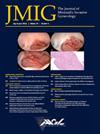High-Volume Surgeons and Reducing Racial Disparities in Route of Hysterectomy
IF 3.5
2区 医学
Q1 OBSTETRICS & GYNECOLOGY
引用次数: 0
Abstract
Study Objective
To examine racial disparities in route of hysterectomy and perioperative outcomes before and after expansion of high-volume minimally invasive surgeons (>10 minimally invasive hysterectomies [MIHs]/year).
Design
Retrospective cohort study.
Setting
Multicenter academic teaching institution.
Patients
All patients who underwent a scheduled hysterectomy for benign indications during 2018 (preintervention) and 2022 (postintervention).
Interventions
Recruitment of fellowship in minimally invasive gynecologic surgery–trained faculty and increased surgical training for academic specialists in obstetrics and gynecology occurred in 2020.
Measurements and Main Results
Patients in the preintervention cohort (n = 171) were older (median age, 45 years vs 43 years; p = .003) whereas patients in the postintervention cohort (n = 234) had a higher burden of comorbidities (26% American Society of Anesthesiologists class III vs 19%; p = .03). Uterine weight was not significantly different between cohorts (p = .328). Between the pre- and postintervention cohorts, high-volume minimally invasive surgeons increased from 27% (n = 4) to 44% (n = 7) of those performing hysterectomies within the division and percentage of hysterectomies performed via minimally invasive route increased (63% vs 82%; p <.001). In the preintervention cohort, Black patients had a lower percentage of hysterectomies performed via minimally invasive route than White patients (Black = 56% MIH vs White = 76% MIH; p = .014). In the postintervention cohort, differences by race were no longer significant (Black = 78% MIH vs White = 87% MIH; p = .127). There was a significant increase (22%) in MIH for Black patients between cohorts (p <.001). After adjusting for age, body mass index, American Society of Anesthesiologists class, previous surgery, and uterine weight, disparities by race were no longer present in the postintervention cohort. Perioperative outcomes including length of stay (p <.001), infection rates (p = .002), and blood loss (p = .01) improved after intervention.
Conclusion
Increasing fellowship in minimally invasive gynecologic surgery–trained gynecologic surgeons and providing more opportunities in robotic/laparoscopic training for academic specialists may improve access to MIH for Black patients and reduce disparities.
大量外科医生和减少子宫切除术路径中的种族差异。
研究目的研究高容量微创外科医生(>10 例微创子宫切除术 (MIH)/年)扩张前后,子宫切除术路径和围手术期结果的种族差异:多中心学术教学机构 患者:2018年(干预前)和2022年(干预后)期间所有因良性适应症接受预定子宫切除术的患者:2020年,招募受过妇科微创手术研究员培训的教师,并增加妇产科学术专家的手术培训:干预前队列(n=171)的患者年龄较大(中位年龄为45岁 vs. 43岁,p=0.003),而干预后队列(n=234)的患者合并症较多(26% ASA III级 vs. 19%,p=0.03)。各组间的子宫重量无明显差异(P=0.328)。在干预前和干预后的队列中,该分部内进行子宫切除术的高容量微创外科医生从27%(4人)增加到44%(7人),通过微创途径进行子宫切除术的比例也有所上升(63%对82%,P=0.03):增加接受过FMIGs培训的妇科外科医生,并为学术专家提供更多的机器人/腹腔镜培训机会,可改善黑人患者接受MIH的机会,并减少差异。
本文章由计算机程序翻译,如有差异,请以英文原文为准。
求助全文
约1分钟内获得全文
求助全文
来源期刊
CiteScore
5.00
自引率
7.30%
发文量
272
审稿时长
37 days
期刊介绍:
The Journal of Minimally Invasive Gynecology, formerly titled The Journal of the American Association of Gynecologic Laparoscopists, is an international clinical forum for the exchange and dissemination of ideas, findings and techniques relevant to gynecologic endoscopy and other minimally invasive procedures. The Journal, which presents research, clinical opinions and case reports from the brightest minds in gynecologic surgery, is an authoritative source informing practicing physicians of the latest, cutting-edge developments occurring in this emerging field.

 求助内容:
求助内容: 应助结果提醒方式:
应助结果提醒方式:


